Influence of Consumption Decisions of Rural Residents in the Context of Rapid Urbanization: Evidence from Sichuan, China
Abstract
1. Introduction
2. Influencing Factors of Rural Residents’ Consumption Decision Making
2.1. An Analysis of Psychological Factors in Rural Residents’ Consumption Decision Making
2.2. The Influence of Household Income and Education Level on Consumer Decision Making
3. Research Methods
3.1. Research Content
- (1)
- Research Subjects
- (2)
- Research Design
- a.
- Questionnaire Design
- b.
- Questionnaire Survey
- c.
- In-depth Interviews
- d.
- Data Analysis
- e.
- Respondent Statistics
3.2. Analysis of Reliability and Validity
- (1)
- Reliability Analysis
- (2)
- Validity Analysis
4. Analysis of Factors Influencing Consumer Decision Making among Rural Residents
4.1. Descriptive Statistics
4.2. Regression Analysis
4.3. Discussion
5. Conclusions
Author Contributions
Funding
Institutional Review Board Statement
Informed Consent Statement
Data Availability Statement
Conflicts of Interest
References
- Zhang, T.; Peng, J.; Cao, X. China’s Urban and Rural Development Significantly Affects the Pattern of Human Appropriation of Net Primary Production. Land 2023, 12, 1062. [Google Scholar] [CrossRef]
- Pu, X. Analysis of Current Status and Influencing Factors of Spatial Differences in Urbanization Development in Sichuan Province. DEStech Trans. Econ. Bus. Manag. 2018, 11, 10–14. [Google Scholar] [CrossRef][Green Version]
- Zi, C.; Qian, M.; Baozhong, G. The consumption patterns and determining factors of rural household energy: A case study of Henan Province in China. Renew. Sustain. Energy Rev. 2021, 146, 111142. [Google Scholar]
- Luo, S.; Sun, Y.; Zhou, R. Can fintech innovation promote household consumption? Evidence from China family panel studies. Int. Rev. Financial Anal. 2022, 82, 102137. [Google Scholar] [CrossRef]
- Tang, S.; Hao, P.; Feng, J. Consumer behavior of rural migrant workers in urban China. Cities 2020, 106, 102856. [Google Scholar] [CrossRef]
- Fanying, M.; Yueqing, X.U.; Lijin, Z. Food Consumption and Policy Implications of Urban and Rural Residents in China. Resour. Sci. 2010, 32, 1333–1341. [Google Scholar]
- Zhao, G. Rural Residents’ Income Structure, Population Aging and Tourism Consumption: Evidence from China. Rev. Cercet. Interv. Soc. 2018, 63, 200–219. [Google Scholar]
- Fathy, Y.; Jaber, M.; Nadeem, Z. Digital twin-driven decision making and planning for energy consumption. J. Sens. Actuator Netw. 2021, 10, 37. [Google Scholar] [CrossRef]
- Yin, J.; Shi, S. Social interaction and the formation of residents′ low-carbon consumption behaviors: An embeddedness perspective. Resour. Conserv. Recycl. 2020, 164, 105116. [Google Scholar] [CrossRef]
- Schubert, S.F.; Schamel, G. Sustainable tourism development: A dynamic model incorporating resident spillovers. Tour. Econ. 2020, 27, 1561–1587. [Google Scholar] [CrossRef]
- Jia, Y.; Cheng, S.; Shi, R. Decision-making behavior of rural residents’ domestic waste classification in Northwestern of China—Analysis based on environmental responsibility and pollution perception. J. Clean. Prod. 2021, 326, 129374. [Google Scholar] [CrossRef]
- Levin, I.P.; Jasper, D.J. Experimental analysis of nationalistic tendencies in consumer decision processes: Case of the multinational product. J. Exp. Psychol. Appl. 1996, 2, 17–30. [Google Scholar] [CrossRef]
- Solka, A.; Jackson, V.P.; Lee, M.-Y. The influence of gender and culture on Generation Y consumer decision making styles. Int. Rev. Retail. Distrib. Consum. Res. 2011, 21, 391–409. [Google Scholar] [CrossRef]
- Nasab, M.A.; Zand, M.; Eskandari, M.; Sanjeevikumar, P.; Siano, P. Optimal Planning of Electrical Appliance of Residential Units in a Smart Home Network Using Cloud Services. Smart Cities 2021, 4, 1173–1195. [Google Scholar] [CrossRef]
- Baba, S.; Alexander, F. Heart and Mind in Conflict: The Interplay of Affect and Cognition in Consumer Decision Making. J. Consum. Res. 1999, 26, 278–292. [Google Scholar]
- Yazdanparast, A.; Alhenawi, Y. Impact of COVID-19 pandemic on household financial decisions: A consumer vulnerability perspective. J. Consum. Behav. 2022, 21, 806–827. [Google Scholar] [CrossRef] [PubMed]
- Jose, V. Influence of Customers Trust, Satisfaction and Perceived Listening Ability of the Sales Person on Anticipated Purchases. Int. J. Mark. Technol. 2011, 1, 237–248. [Google Scholar]
- Si, R.; Lu, Q.; Aziz, N. Impact of COVID-19 on peoples’ willingness to consume wild animals: Empirical insights from China. One Health 2021, 12, 100240. [Google Scholar] [CrossRef]
- Giráldez-Cru, J.; Chica, M.; Cordón, O. An Integrative Decision-Making Mechanism for Consumers’ Brand Selection using 2-Tuple Fuzzy Linguistic Perceptions and Decision Heuristics. Int. J. Fuzzy Syst. 2022, 25, 59–79. [Google Scholar] [CrossRef]
- Fang, W.-T.; Huang, M.-H.; Cheng, B.-Y.; Chiu, R.-J.; Chiang, Y.-T.; Hsu, C.-W.; Ng, E. Applying a Comprehensive Action Determination Model to Examine the Recycling Behavior of Taipei City Residents. Sustainability 2021, 13, 490. [Google Scholar] [CrossRef]
- Kalcheva, I.; McLemore, P.; Sias, R. Economic Policy Uncertainty and Self-Control: Evidence from Unhealthy Choices. J. Financial Quant. Anal. 2020, 56, 1446–1475. [Google Scholar] [CrossRef]
- Guo, J.; Liao, M.; He, B.; Liu, J.; Hu, X.; Yan, D.; Wang, J. Impact of the COVID-19 pandemic on household disinfectant consumption behaviors and related environmental concerns: A questionnaire-based survey in China. J. Environ. Chem. Eng. 2021, 9, 106168. [Google Scholar] [CrossRef]
- Chan, A.; Sam’, N.; Raharja, U.J. Analysis of factors that influence consumer purchasing decisions on creative industries in Bandung City, Indonesia. Int. J. Trade Glob. Mark. 2021, 14, 213. [Google Scholar] [CrossRef]
- Yue, T.; Liu, J.; Long, R.; Chen, H.; Li, Q.; Liu, H.; Gu, Y. Effects of perceived value on green consumption intention based on double-entry mental accounting: Taking energy-efficient appliance purchase as an example. Environ. Sci. Pollut. Res. 2020, 28, 7236–7248. [Google Scholar] [CrossRef] [PubMed]
- Lee, J. Urban-rural differences in intention to age in place while receiving home care services: Findings from the National Survey of Older Koreans. Arch. Gerontol. Geriatr. 2022, 101, 104690. [Google Scholar] [CrossRef]
- Pop, R.-A.; Săplăcan, Z.; Dabija, D.-C.; Alt, M.-A. The impact of social media influencers on travel decisions: The role of trust in consumer decision journey. Curr. Issues Tour. 2021, 25, 823–843. [Google Scholar] [CrossRef]
- Tiansi, C.; Hui, T.; Kabinga, T.; Ruoqing, Z. Unlocking the Network Traffic Password of the Sudden Popularity of Oriental Selection: Consumer Behavior Decision-Making Mechanism Based on Mental Accounting Theory. Psychol. Res. 2022, 12, 879–889. [Google Scholar] [CrossRef]
- Tang, J.; Zhang, X.; Min, X. Empirical Research on Difference of Source of Income on Urban and Rural Residents’ Consumption. Henan Sci. 2015, 33, 639–644. [Google Scholar]
- Cheng, Z. Education and consumption: Evidence from migrants in Chinese cities. J. Bus. Res. 2021, 127, 206–215. [Google Scholar] [CrossRef]
- Li, L.; Zhai, S.-X.; Bai, J.-F. The dynamic impact of income and income distribution on food consumption among adults in rural China. J. Integr. Agric. 2020, 20, 330–342. [Google Scholar] [CrossRef]
- Hu, Y.; Su, M.; Sun, M.; Wang, Y.; Xu, X.; Wang, L.; Zhang, L. Environmental footprints of improving dietary quality of Chinese rural residents: A modeling study. Resour. Conserv. Recycl. 2021, 179, 106074. [Google Scholar] [CrossRef]
- Li, Y.; Filimonau, V.; Wang, L.-E.; Cheng, S. Inter- and intra-annual changes in food consumption among rural households in East China. J. Rural. Stud. 2022, 95, 109–124. [Google Scholar] [CrossRef]
- Cui, L.; Wang, Y.; Chen, W.; Wen, W.; Su Han, S. Predicting determinants of consumers’ purchase motivation for electric vehicles: An application of Maslow’s hierarchy of needs model. Energy Policy 2021, 151, 112167. [Google Scholar] [CrossRef]
- Ma, S.; Xu, X.; Li, C.; Zhang, L.; Sun, M. Energy consumption inequality decrease with energy consumption increase: Evidence from rural China at micro scale. Energy Policy 2021, 159, 112638. [Google Scholar] [CrossRef]
- Ma, X.; Wang, M.; Chen, D.; Li, C. Energy choice in rural household cooking and heating: Influencing factors and transformation patterns. Environ. Sci. Pollut. Res. 2021, 28, 36727–36741. [Google Scholar] [CrossRef]
- Li, X. Local government decision-making competition and regional carbon emissions: Experience evidence and emission re-duction measures. Sustain. Energy Technol. Assess. 2022, 50, 101800. [Google Scholar] [CrossRef]
- Zhao, S.; Chen, L. Exploring Residents’ Purchase Intention of Green Housings in China: An Extended Perspective of Perceived Value. Int. J. Environ. Res. Public Health 2021, 18, 4074. [Google Scholar] [CrossRef]
- Issock, P.B.I.; Muposhi, A. Understanding energy-efficiency choices through consumption values: The central role of consumer’s attention and trust in environmental claims. Manag. Environ. Qual. 2023, 34, 250–270. [Google Scholar] [CrossRef]
- Fu, H.; Niu, J.; Wu, Z.; Xue, P.; Sun, M.; Zhu, H.; Cheng, B. Influencing Factors of Stereotypes on Wastewater Treatment Plants- Case Study of 9 Wastewater Treatment Plants in Xi’an, China. Environ. Manag. 2022, 70, 526–535. [Google Scholar] [CrossRef]
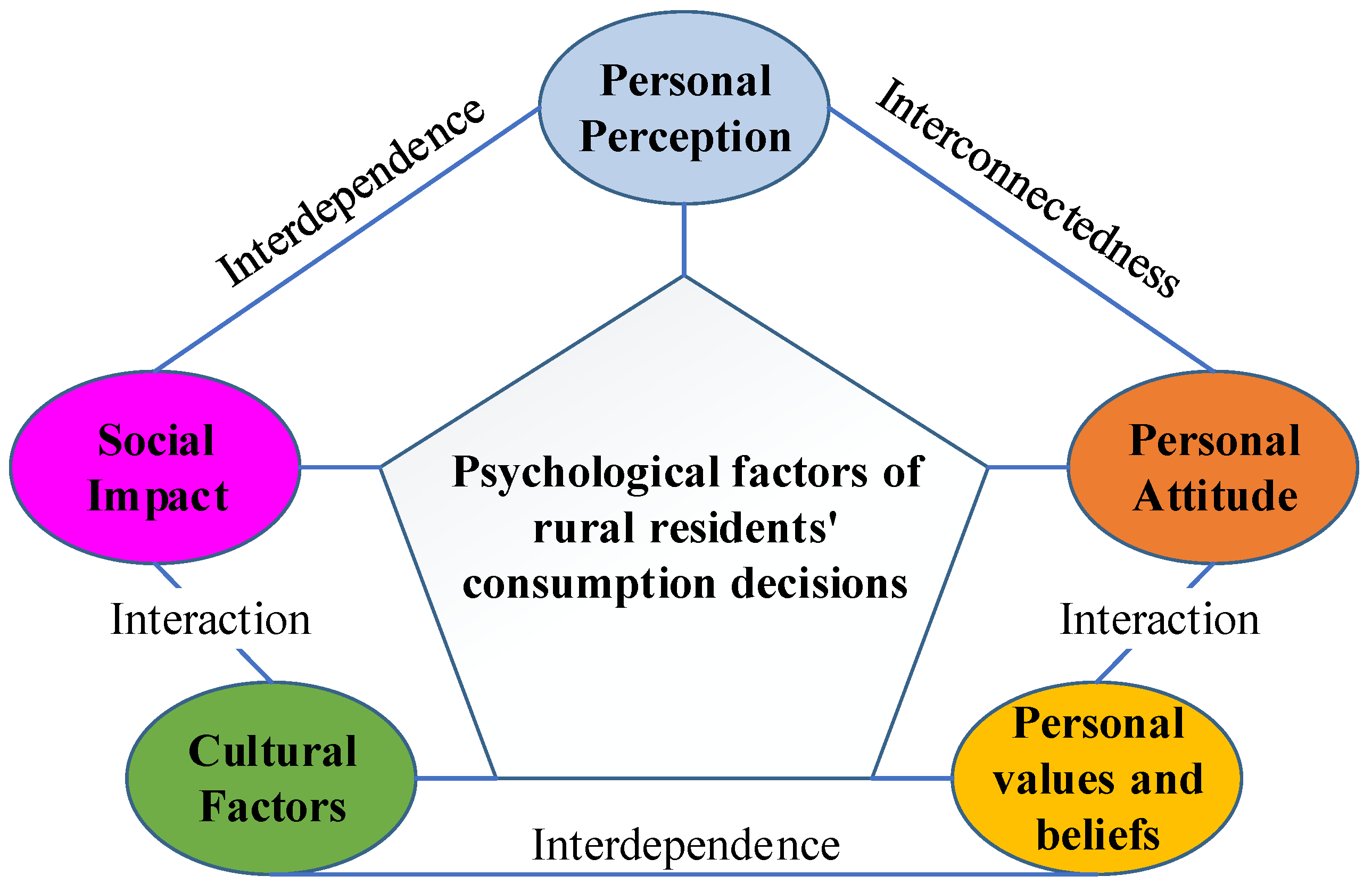
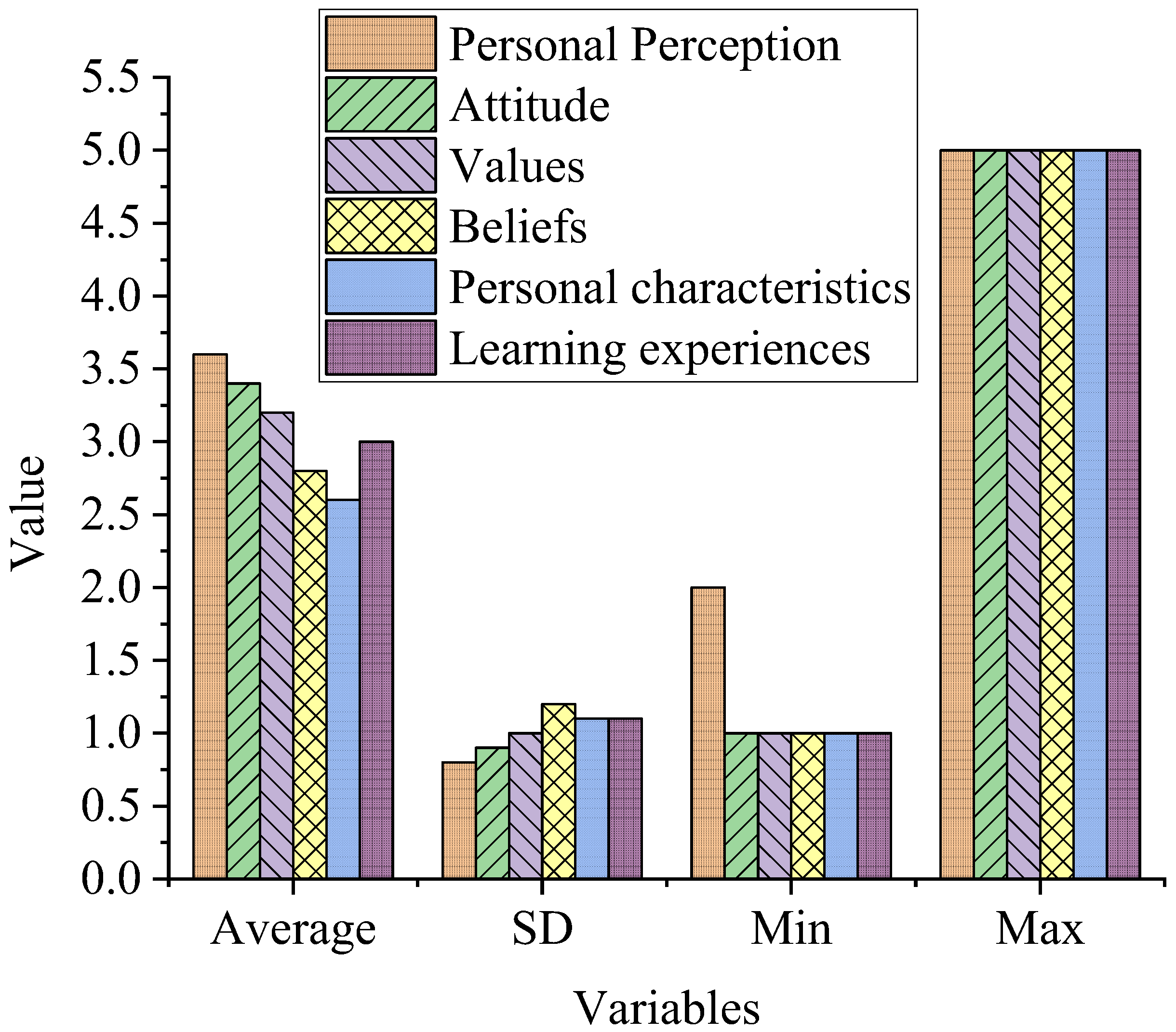
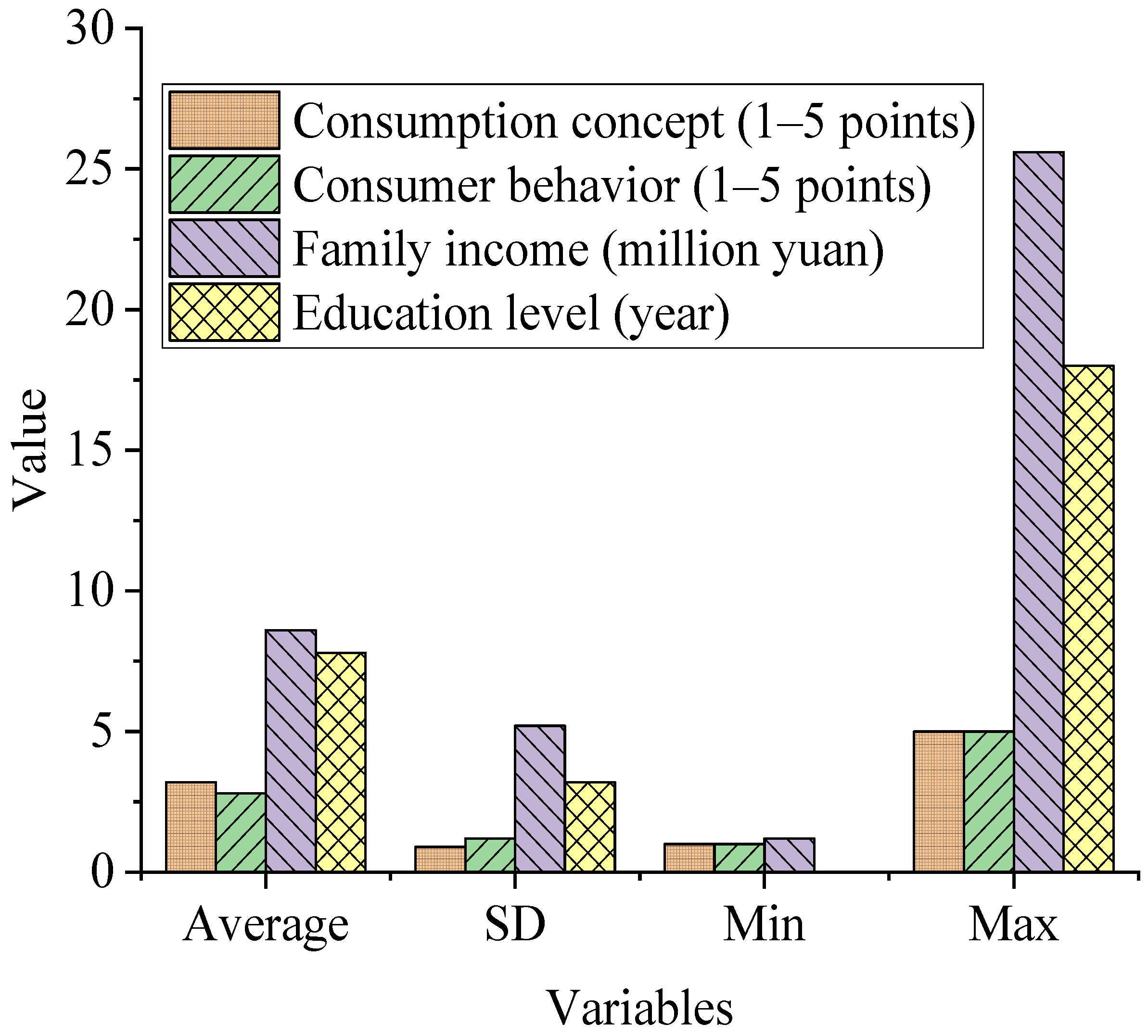
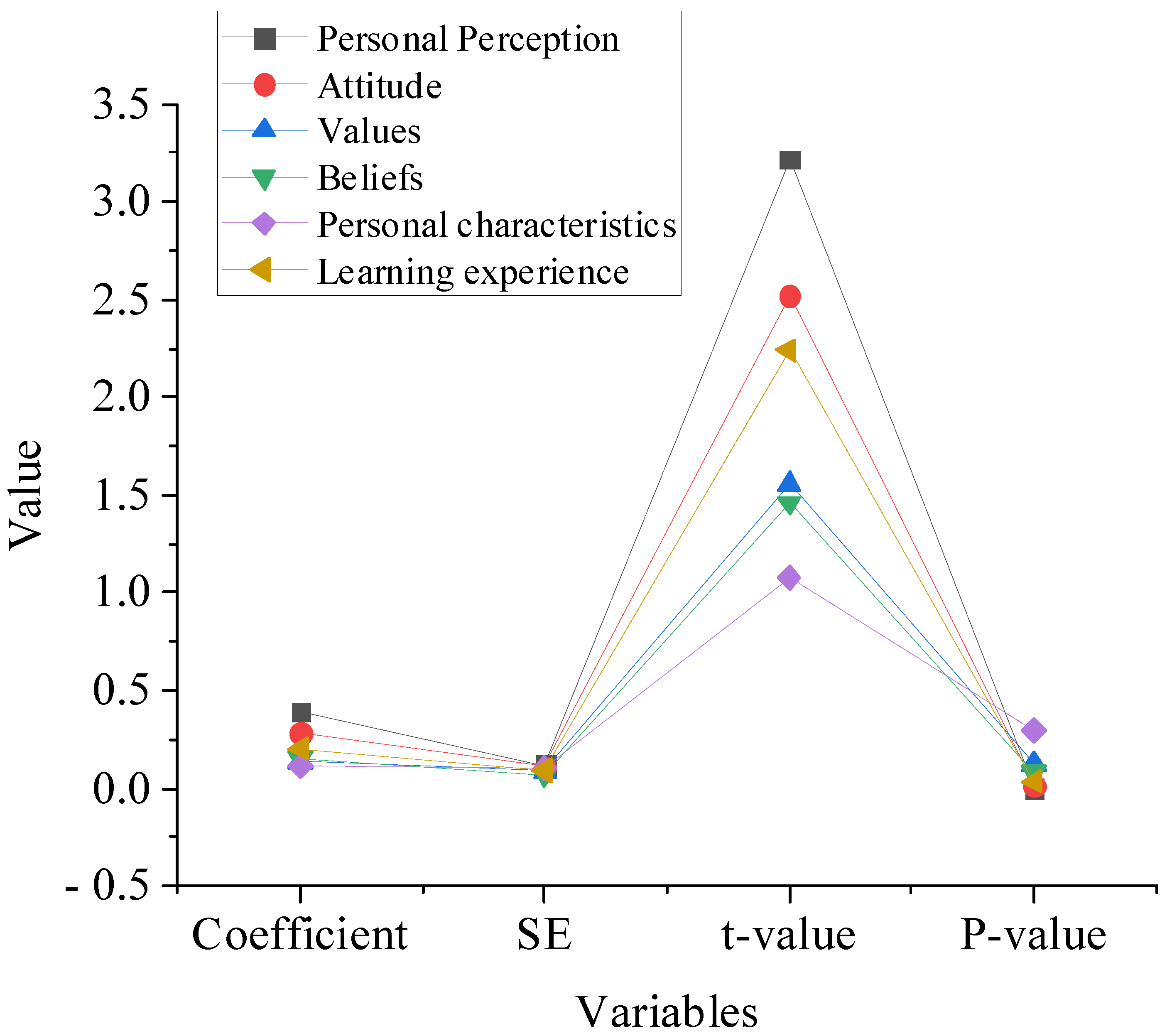
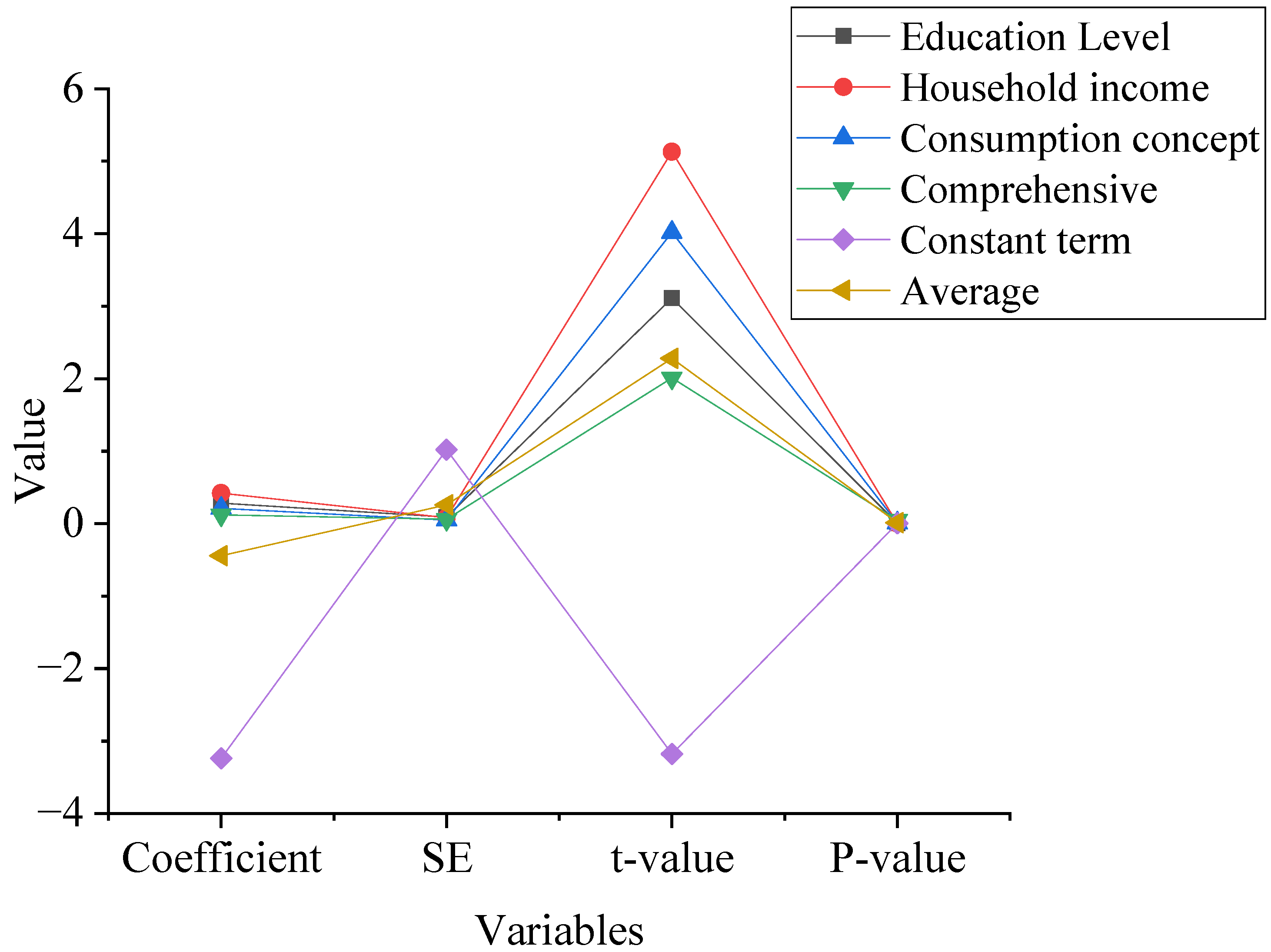
| Demographic Characteristic | Classification | Percentage | Population |
|---|---|---|---|
| Gender | male | 55% | 165 |
| female | 45% | 135 | |
| Age | 18–24 years old | 20% | 60 |
| 25–34 years old | 40% | 120 | |
| 35–44 years old | 25% | 75 | |
| over 45 years old | 15% | 45 | |
| Education level | primary school and below | 10% | 30 |
| junior high school | 30% | 90 | |
| high school and above | 60% | 180 | |
| Income of family | below average | 20% | 60 |
| average | 50% | 150 | |
| above average | 30% | 90 | |
| marital status | married | 70% | 210 |
| unmarried | 30% | 90 | |
| Profession | farming | 80% | 240 |
| other industry | 20% | 60 |
| Independent Variable | Coefficient | SE | t-Value | p-Value |
|---|---|---|---|---|
| Personal Perception | 0.39 | 0.12 | 3.22 | 0.002 |
| Attitude | 0.28 | 0.11 | 2.52 | 0.014 |
| Values | 0.14 | 0.09 | 1.56 | 0.128 |
| Beliefs | 0.15 | 0.07 | 1.46 | 0.084 |
| Cultural Factors | 0.11 | 0.1 | 1.08 | 0.296 |
| Social Impact | 0.2 | 0.09 | 2.24 | 0.032 |
| Independent Variable | Coefficient | t-Value | Significance Level |
|---|---|---|---|
| Personal cognition | 0.48 | 4.56 | 0.001 |
| Values | 0.05 | 0.65 | 0.52 |
| Beliefs | −0.02 | −0.25 | 0.81 |
| Personal characteristics | 0.08 | 0.95 | 0.34 |
| Learning experience | 0.22 | 2.34 | 0.03 |
| Independent Variable | Coefficient | t-Value | Significance Level |
|---|---|---|---|
| Education level | 0.23 | 2.34 | 0.03 |
| Household income | 0.45 | 4.56 | 0.001 |
| Consumption attitude | 0.18 | 1.89 | 0.07 |
| Composite factors | 0.1 | 1.23 | 0.22 |
| For Internal Factors | For External Factors | ||
|---|---|---|---|
| Independent Variable | VIF value | Independent Variable | VIF value |
| Personal cognition | 2.34 | Education level | 2.12 |
| Values | 1.98 | Household income | 3.45 |
| Beliefs | 1.79 | Consumer attitudes | 1.99 |
| Personal characteristics | 2.12 | Composite factors | 1.78 |
| Learning experience | 2.45 | ||
Disclaimer/Publisher’s Note: The statements, opinions and data contained in all publications are solely those of the individual author(s) and contributor(s) and not of MDPI and/or the editor(s). MDPI and/or the editor(s) disclaim responsibility for any injury to people or property resulting from any ideas, methods, instructions or products referred to in the content. |
© 2023 by the authors. Licensee MDPI, Basel, Switzerland. This article is an open access article distributed under the terms and conditions of the Creative Commons Attribution (CC BY) license (https://creativecommons.org/licenses/by/4.0/).
Share and Cite
Lin, X.; Qi, Y. Influence of Consumption Decisions of Rural Residents in the Context of Rapid Urbanization: Evidence from Sichuan, China. Sustainability 2023, 15, 16524. https://doi.org/10.3390/su152316524
Lin X, Qi Y. Influence of Consumption Decisions of Rural Residents in the Context of Rapid Urbanization: Evidence from Sichuan, China. Sustainability. 2023; 15(23):16524. https://doi.org/10.3390/su152316524
Chicago/Turabian StyleLin, Xu, and Yanbin Qi. 2023. "Influence of Consumption Decisions of Rural Residents in the Context of Rapid Urbanization: Evidence from Sichuan, China" Sustainability 15, no. 23: 16524. https://doi.org/10.3390/su152316524
APA StyleLin, X., & Qi, Y. (2023). Influence of Consumption Decisions of Rural Residents in the Context of Rapid Urbanization: Evidence from Sichuan, China. Sustainability, 15(23), 16524. https://doi.org/10.3390/su152316524






